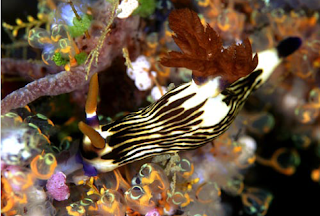 As a still photographer, Raja Ampat appeals to me for its wide angle opportunities, video being the only better tool to capture the area’s wonders. No where else I’ve dived offers such consistent mind boggling vistas of fish and corals. Yet, focusing down to a smaller level there are macro creatures galore. Areas of mushroom shaped rock islands seem to harbour some of the better dive sites and make for beautiful and interesting topside scenery as well. This area is destined to become a World Heritage Site.
As a still photographer, Raja Ampat appeals to me for its wide angle opportunities, video being the only better tool to capture the area’s wonders. No where else I’ve dived offers such consistent mind boggling vistas of fish and corals. Yet, focusing down to a smaller level there are macro creatures galore. Areas of mushroom shaped rock islands seem to harbour some of the better dive sites and make for beautiful and interesting topside scenery as well. This area is destined to become a World Heritage Site.Dr Gerald Allen declared recently that “Raja Ampat represents the bulls-eye of biodiversity in coral reefs” and recommended “we protect the reef at all costs, because it represents the baseline to which all other reefs in the world be compared.” Raja Ampat is considered remote. Located off the Northwest “Bird’s Head”
Peninsula of New Guinea Island, Raja Ampat is a cluster of over 1500 small islands, bays and shoals surrounding the four islands of Misool, Salawati, Batanta and Waigeo. Named after the “Four Kings” of these
islands, Raja Ampat is a part of the West Papua province of Indonesia which was formerly Irian Jaya and is now its own district with its own government.
“Remote” depends on your definition. While much of the area is unexplored, it is easy enough to fly by jet into the local Sorong airport from Manado or Makassar (Ujung Pandang) where you are collected by ship to travel an hour or so to the diving areas.
Favourite Sites
for Small Creatures One of the favourite macro photography sites on the trip was in a deep bay on the western end of Waigeo where a long wall alternates with a steep slope both covered in corals and anemones and shadowed by rainforest from the island above. The site is populated by orang-utan crabs, ghost pipefish, a great variety of nudibranchs, several species of lionfish and of course, pygmy seahorses. Pygmy seahorses seem to be everywhere, so we restrict ourselves to looking for them on designated macro days when we are diving in calm areas.
This site could be dived from 30 meters to the surface so bottom time was no problem. We took advantage
of this by spending the entire day at this site, most of it in the water. Highlights were the abundance of orang-utan crabs, striking orange ‘pygs’ (pygmy seahorses) on a matching fan, a giant zebra crab on a fire
urchin, and bizarre Phyllodesmium species nudibranch, juvenile egg cowries and both robust and ornate ghost
pipefish.
The dive site is long and protected. Although there occasionally was a current, there was no chance of getting
lost or being swept away and there was always a sheltered area. What we found immediately were schools of silversides so dense they would turn day into night when overhead. Even in the brightest part of the day, I would need a light to enable me to focus on the robust ghost pipefish or on the tiny crabs in the fire urchins.
Every bubble coral had its orangutan crab. Nudibranchs and flatworms were scattered like confetti over
much of the site. There was always something interesting to be found on the soft corals, among the algae or
in the holes. Rainbow-coloured mantis shrimp would sit up and watch as divers swam past then dart toward
their hole when approached.
 Certain areas were covered in the small yellow holothurians (sea cucumbers) that are common in Indonesia as well as an orange and green coloration that I had never seen before. Divers came and went as they pleased all
Certain areas were covered in the small yellow holothurians (sea cucumbers) that are common in Indonesia as well as an orange and green coloration that I had never seen before. Divers came and went as they pleased allday changing locations as they learned what others found in their explorations, trading information on critters, their depth and landmarks to find them. On the second dive, I came upon a beautiful orange sea fan perched on a sandy ledge in the wall. It was such a beautiful colour that I searched it carefully for any small creature to use as a subject for a photo composition.
Imagine my surprise when I found three nice-sized pygmy seahorses! I marked the fan with a nearby stick that had fallen from the rainforest above, sticking it vertically into the sand. Other divers were able to locate the
fan and get some photos of these cool ‘pygs’. After a lengthy night dive at the site, we started the long overnight leg of the cruise. Everyone sat down for a dinner of Indonesian specialities inside SMY Ondina’s
air conditioned dining room and lounge.














Wow Excellent This Tour
ReplyDeleteThanks Friend share article
By http://animaldiscovery-chanel.blogspot.com